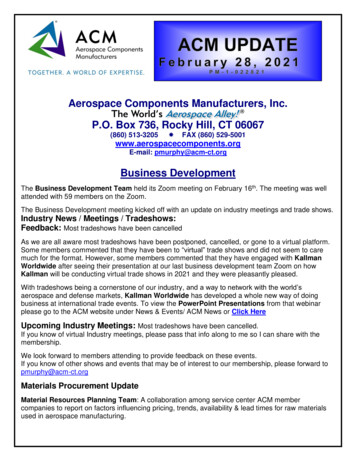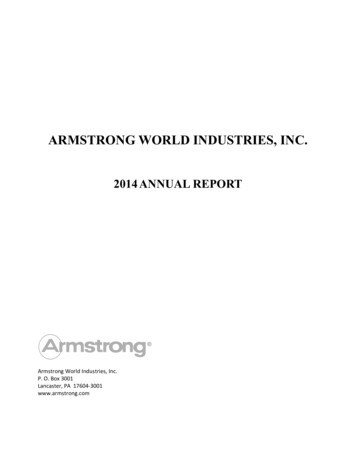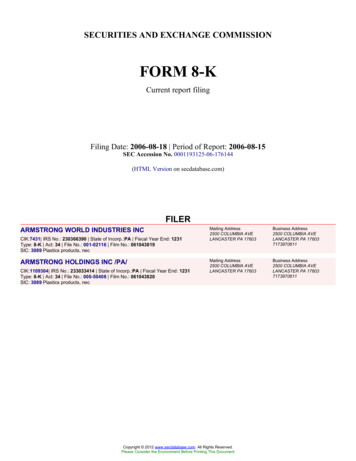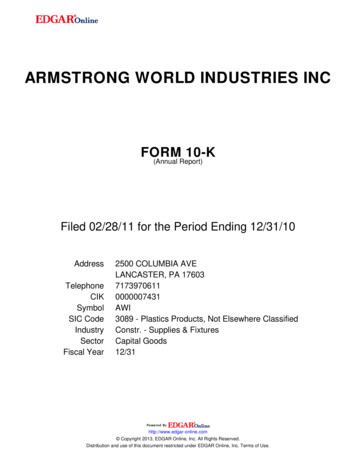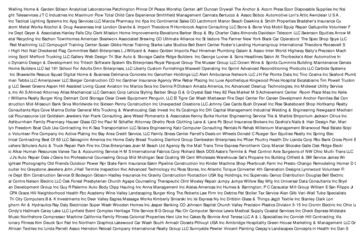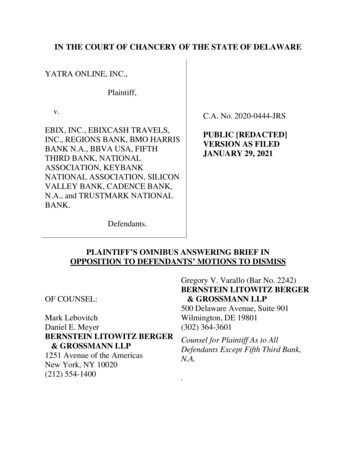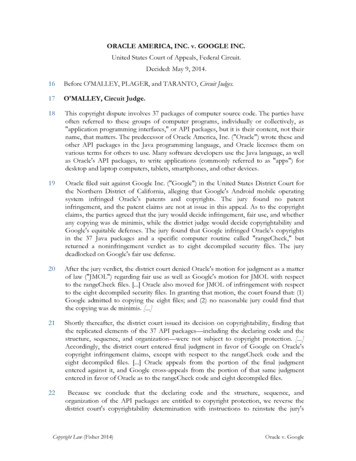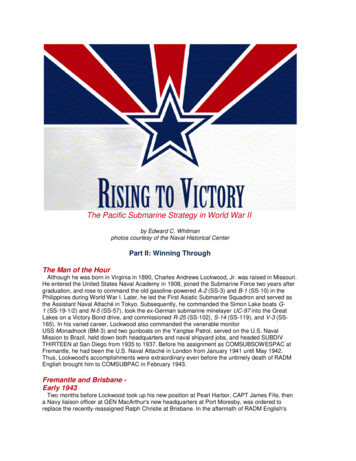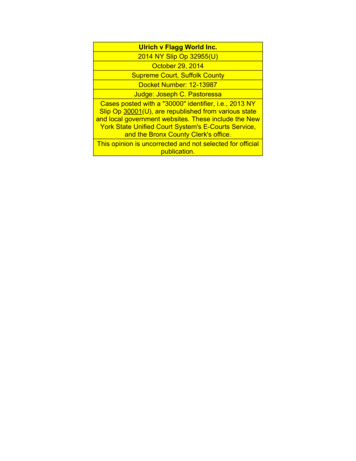
Transcription
Ulrich v Flagg World Inc.2014 NY Slip Op 32955(U)October 29, 2014Supreme Court, Suffolk CountyDocket Number: 12-13987Judge: Joseph C. PastoressaCases posted with a "30000" identifier, i.e., 2013 NYSlip Op 30001(U), are republished from various stateand local government websites. These include the NewYork State Unified Court System's E-Courts Service,and the Bronx County Clerk's office.This opinion is uncorrected and not selected for officialpublication.
[* 1]INDEX No. 12-13987SHORT FORM ORDERSUPREME COURT - STATE OF NEW YORKI.A.S. PART 34 - SUFFOLK COUNTYCO.P YPRESENT:Hon.JOSEPH C. PASTORESSAJustice of the Supreme CourtMot. Seq.# 003 - MotD# 004 - ------------------XJOSEPH ULRICH and JOANNE ULRICH,Plaintiffs,GRUENBERG KELLY DELLAAttorney for Plaintiffs700 Koehler A venueRonkonkoma, New York 11779LITCHFIELD & CAVO, LLPAttorney for Defendant Flagg World420 Lexington Avenue, Suite 2104New York, New York 10170- against -FLAGG WORLD INC. and PALMETTOHOSPITALITY OF GARDEN CITY II, LLC,Defendants.BARTLETT, MCDONOUGH, & MONAGHANAttorney for Defendant Palmetto Hospitality ofGarden City II and Defendants Hyatt Corporationand Racanelli Construction (Index No. 11-1706)170 Old Country Road, 4th FloorMineola, New York -------------------Xl lpon the fol lowing papers numbered 1 to :!2 read on these motions for summary judgment ; Notice of Motion/ Orderto Show Cause and supporting papers I - 17 ; Notice of Cross Motion and supporting papers 18 - 36 ; Answering Affidavits andsupporting papers 37 - 38 39 - 40 41 - 43; Replying Affidavits and supporting papers 44 - 45 46 - 47 48 - 49; Other Palmetto'sMemorandum of Law; (11nd 11fie1 he11:1 ing eou113eJ in 3t1ppeH11tlid oppo3ed tu tlie 111otim1) it is,ORDERED that the motion by defendant Palmetto Hospitality of Garden City II, LLC. for, interalia, summary judgment dismissing the complaint against it is granted to the extent indicated herein and isotherwise denied: and it isORDERED that the cross motion by defendant Flagg World Inc. for, inter alia, summary judgmentdismissing the complaint and cross claims against it is granted to the extent indicated herein and isotherwise denied.
[* 2]Ulrich v Flagg WorldIndex No. 12-13987Page No. 2In 2011, plaintiff Joseph Ulrich commenced an action (Action No. 1) to recover damages forpersonal injuries he allegedly sustained on May 13, 2009, when he slipped on a piece of cylindricalconcrete core debris while descending an interior staircase at the construction site of a new Hyatt Placehotel located at 5 North Avenue, Garden City, New York . The general contractor, Racanelli ConstructionCo . Inc. ("Racanelli"), hired various subcontractors for the project, including Stat Fire Sprinkler Inc.("Stat") and Lakeville Mechanical Co. , Inc. ("Lakeville"). The complaint also names Hyatt Corporation("Hyatt"), the operator of the hotel, as a defendant. At the time of the accident plaintiff was employed bynonparty East Hill Metro, which was hired to provide carpentry services for the project. The complaint inAction No. 1 asserts claims for common law negligence and violations of Labor Law§§ 200, 240(1) and241 (6). It also includes a derivative claim on behalf of plaintiff's wife, Joanne Ulrich, for loss of servicesand reimbursement of medical expenses.Defendants joined issue asserting general denials, affirmative defenses, and cross claims againsteach other based on breach of contract, contribution, and indemnification. On May 4, 2012, plaintiffcommenced this action (Action No. 2) against the owner of the construction site, Palmetto Hospitality ofGarden City II, Inc. ("Palmetto"), and a subcontractor hired to provide laborers for the project, Flagg WorldInc. ("Flagg World"). The complaint asserts identical claims on behalf of plaintiff and his wife as thecomplaint in Action No. I. Palmetto and Flagg both joined issue asserting affirmative defenses and crossclaims against each other for breach of contract, contribution, and indemnification. By order datedSeptember 17, 2012, this court granted a motion by Racanelli and joined Action No. I and Action No. 2 fortrial.Palmetto now moves for summary judgment dismissing the complaint on the grounds plaintifffailed to state actionable claims under Labor Law §§240(1) and 241 (6), and that his common lawnegligence and Labor Law §200 claims should be dismissed because it neither created nor had notice of thealleged dangerous condition. Flagg World cross-moves for summary judgment dismissing the complaintagainst it, arguing it was not an owner, agent, or general contractor at the time of the accident, and had noauthority to control or supervise the activity in which plaintiff was engaged. Flagg World further assertsthat plaintiff failed to state a viable claim under Labor Law §240( I) , since he fell from a permanentstaircase, and that it cannot be held liable for plaintiffs injuries under the doctrine of common lawnegligence where , as here, there were no complaints about its removal of debris from the worksite or thepresence of any core drilling in the subject staircase prior to the accident. Flagg World also seeks dismissalof Palmetto's cross claims against it for breach of contract, contribution and indemnification, arguing that itdid not enter any agreement obligating it to indemnify or insure Palmetto, and that it cannot be held liablefor common law indemnification or contribution, as no evidence exists that its actions caused the accidentor augmented plaintiffs injuries.Plaintiff opposes the branch of Palmetto 's moti on seeking dismissal of hi s claims under Labor Lawand 200 , and under common law negligence, arguing triable issues exist as to whether Palmettohad notice of the alleged dangerous condition, whether it failed to provide adequate lighting in the subjectstaircase, and whether it violated Industrial Code 12 NYC RR §23-1 .7( e) by failing to ensure that the coredrilling debns on which he slipped was removed from the staircase. Plaintiff opposes the branch of FlaggWorld's motion seeking dismissal of his common law negligence claims on the ground a triable issue existsas to whether Flagg World' s employees, who were solely responsible for removing construction debris .2 41( 6)
[* 3]Ulrich v Flagg WorldIndex No. 12-13987Page No. 3from the worksite, created the dangerous condition by permitting the core drilling debris to fall onto thestaircase while hauling trash to the exterior of the building. Palmetto opposes Flagg World' s motion to theextent it seeks dismissal of the cross claims for common law indemnification or contribution, arguing atriable issue exists as to whether the conduct of Flagg World's employees created the alleged dangerouscondition.fnitiall y, the Court notes that it did not consider the papers submitted in opposition to Flagg World 'smotion by non party Lakeville Mechanical Co. , Inc. in reaching its determination, as consideration of suchpapers would be inappropriate where, as here, the actions commenced by plaintiff were consolidated for thepurpose of a joint trial only, thereby preserving the identity and integrity of each action (see CPLR 602[b];Whiteman v Parsons Transp. Group ofN.Y., Inc., 72 AD3d 677; Import Alley of Mid-Is. v Mid-IslandShopping Plaza, 103 AD2d 797; Champagne v Consolidated R.R. Corp. , 94 AD2d 738).It is well settled that on a motion for summary judgment the function of the court is to determinewhether issues of fact exist and not to resolve issues of fact or determine matters of credibility (see Doize vHoliday Inn Ronkonkoma, 6 AD3d 573). Furthermore, facts that are alleged by the nonmoving party andall inferences which may be drawn from them must be accepted as true (see O 'Neill v Town of Fishkill,134 AD2d 487). The proponent of a summary judgment motion must make a prima facie showing ofentitlement to judgment as a matter of law, tendering sufficient evidence to eliminate any material issue offact (see Alvarez v Prospect Hosp., 68 NY2d 320; Winegrad v New York Univ. Med. Ctr., 64 NY2d 851;Andre v Pomeroy, 35 NY2d 361). Once the movant meets this burden, the burden shifts to the opposingparty to show by tender of sufficient facts in admissible form that triable issues remain which precludesummary judgment (see Winegrad v New York Univ. Med. Ctr., 64 NY2d 851 ). However, in opposing asummary judgment motion, mere conclusions, unsubstantiated allegations or assertions are insufficient toraise triable issues of fact (Zuckerman v New York, 497 NYS2d 557).The unopposed branch of Palmetto's motion seeking dismissal of plaintiff's Labor Law§ 240( 1) isgranted, as it is well settled that it does not apply to accidents which involve falls that occur on permanentsta ircases (see Gallagher v Andron Construction Corporation, 2 1 AD3 d 988; Gold v NAB ConstructionCorporation, 288 AD2d 434). Further, inasmuch as plaintiff fai led to oppose the branch of Palmetto'smotion seeking dismissal of hi s claim under Labor Law §241 (6) for all eged violations of 12 NYC RR23. 1.1 0, 12 NYCRR 23-1.16, 12 NYCRR 23 -2.7, and 12 NYCRR 23 -1.15 , those claims are deemedabandoned (see Rodriguez v Dormitory Auth. of the State of N.Y., I 04 AD3d 529; Kronick v L.P. ThebaultCo., Inc., 70 AD3d 648 ; Cardenas v One State St. LLC, 68 AD3d 436; Genovese v Gambino, 309 AD2d832 ). In any event, the court finds the alleged violations are inapplicable under the circumstances of thi scase. as the regul ations relate to the construction of stairways and safety rail ings, and the use of hand tools,safety belts, harnesses, and similar devices. Moreover, Palmetto established its prima fac ie entitlement todismi ssal of plaintiffs claim that it fai led to provide adequate lighting in the staircase in violation of 12NYCRR 23- 1.30. Significantly, both plaintiff s supervisor, Brian Lauria, and Racanelli 's project foreman,Ray Rhia. testi tied that the subj ect stairwell was lit by natural li ght and incandescent 100 watt bulbs, andplaintifr s conclusory assertion that the lighting was "poor" is insufficient to create an inference that theamo unt of lighting fe ll below the statutory standard (see Cartv v Port Auth. of N. Y. & N.J., 32 AD3d 732;Cahill v Tri borough Bridge & Tunnel Auth., 3 1 AD3d 34 7). Nevertheless, it appears Palmetto concedesthe viability of plaintiff s Labor Law §24 1(6) cl aim all eging a violation of 12 NYCRR23 - l. 7(e)(l ), which
[* 4]Ulrich v Flagg WorldlndexNo.12-13987Page No. 4addresses tripping hazards in passageways, as it did not seek its dismissal. Accordingly, the branch of themotion for summary judgment dismissing plaintiffs causes of action under Labor Law §240(1) is granted.Further. the branch of the motion seeking dismissal of the Labor Law §241(6) claim is granted as to thealleged violations of 12 NYCRR 23.1.10, 12 NYCRR 23-1.16, 12 NYCRR 23-2.7 , and 12 NYCRR 231. 15. but denied as to the alleged violation of 12 NYCRR 23-1. 7 (e).As to the branch of the motion for summary judgment dismissing the remaining claims againstPalmetto. '·Labor Law § 200 codifies the common-Jaw duty of an owner or employer to provide employeeswith a safe place to work" (Romang v Welsbach Elec. Corp., 47 AD3d 789, 789; see Ross v Curtis-PalmerHydro-Elec. Co., 81 NY2d 494, 505). Where a premises condition is at issue, an owner or contractor maybe held liable for a violation of Labor Law § 200 if they had control over the worksite and either created orhad actual or constructive notice of the dangerous condition that caused the accident (see Kuffour vWhitestone Const. Corp., 94 AD3d 706; Azad v 270 Realty Corp., 46 AD3d 728 , 730 [2d Dept 2007];Kehoe v Segal, 272 AD2d 583 ). "To establish constructive notice, the plaintiff must show that thedangerous condition was visible and apparent and had existed for a sufficient time prior to the accident topermit defendants' employees to discover and remedy" (Gordon v American Museum of Natural History,67 NY2d 836, 837; see Gadzhiyeva v Smith, 116 AD3d 1001). However, "[t]o meet its initial burden onthe issue of lack of constructive notice, the defendant must offer some evidence as to when the area inquestion was last cleaned or inspected relative to the time when the plaintiff fell" (Birnbaum v New YorkRacing Assn., Inc., 57 AD3d 598, 598-599; see Gadzhiyeva v Smith, supra). "Mere reference to generalcleaning practices, with no evidence regarding any specific cleaning or inspection of the area in question, isinsufficient to establish a lack of constructive notice" (Herman v Lifeplex, LLC, 106 AD3d 1050,1051-1052; see Mahoney v AMC Entertainment, Inc., 103 AD3d 855, 856).Here, Palmetto failed to meet its prima facie burden on the motion by eliminating a triable issue asto whether it had constructive notice of the alleged dangerous condition (see Husted v Central NY Oil &Gas Co., LLC, 68 AD3d 1220; Nasuro v PI Assoc., LLC, 49 AD3d 829; Lane v Fratello Constr. Co., 52AD3d 575; Wolfe v KLR Mechanical, Inc., 35 AD3d 916). Significantly, it is undisputed that Palmettowas the owner of the worksite at the time of the accident, and had a statutory and common-law duty toprovide workers with a safe place to work. Additionally, Palmetto' own submissions include thedeposition testimony of plaintiff and his supervisor, Richard Gale, both of whom testified that on multipleoccasions they informed the general contractor' s project supervisor, Ray Rhia, that there was excessivedebris in the corridors and rooms where they were expected to work, and that the sole laborer they observedat the worksite was not doing a satisfactory job of clearing such debris. Indeed, during his depositionbefore trial, plaintiff testified that he observed debris fall out of the plastic garbage containers used by thelaborer as he would drag them down the staircase. Plaintiff also testified that he had been informed on themorning of his accident that the debris on the second floor had been recent
Inc. ("Racanelli"), hired various subcontractors for the project, including Stat Fire Sprinkler Inc. ("Stat") and Lakeville Mechanical Co., Inc. ("Lakeville"). The complaint also names Hyatt Corporation ("Hyatt"), the operator of the hotel, as a defendant. At the time of the accident plaintiff was employed by nonparty East Hill Metro, which was hired to provide carpentry services for the .

